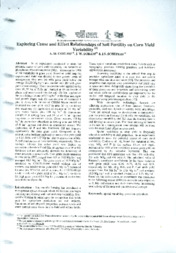Exploring cause and effect relationships of soil fertility on corn yield variability.
Exploring cause and effect relationships of soil fertility on corn yield variability.
Author(s): COELHO, A. M.; DORAM, J. W.; SCHEPERS, J. S.
Summary: In an experimenl conducted 10 asses lhe potencial causes of corn yield variabilily, the variation of phosphorus (P) and manganese (Mn), accounted for 79% of the variability in grain yield. Based on yield map the experimental field was divided in two general areas of management. One area (a) with grain yield below the average (11.30 Mg ha-1) and another one (b) with grain yield above average. Three treatments were applied 10 the corn: (1) 92 kg of P2O5 ha.-1 banded at 10 cm beside of planls and incorporated inlo lhe soil; (2) Mn applied on the com foliage at rate of 1.1 kg ha.-1 at the four and eight- leaf growth stages and, (3) combination of trealment 1 plus 2. Also, with lhe use of CERES-Maize model we eslimated the corn grain yield in area (a) by simulating two situations: (1) appliction of manure at 25 Mg ha-1 (dry matter basis), plus 100 kg ha-1 de ammonium phosphale al sowing time and 50 kg of N ha-1 applied side-dress as ammonium nitrate; (2) no manure, 100 kg ha-1 de ammonium phosphate at sowing time and 100 kg of N ha-1 applied side-dress as ammonium nitrate. The application of P and Mn fertilizers did not improve significantly the corn grain yield. Compared to the control, extra fertilizer application increase the grain yield by 1.25,0,86, and 1.27 Mg ha-1 due to applicalion of Mn, P, and combination of both fertilizers, respectively. These findings indicate that either yield was limited by constraints other than P and Mn, or application of P or Mn fertilizers did not adequately alleviate the deficiency of these nutrients in eroded soils. Corn grain yields measured in area (a) in 1997, ranged from 8.5 to 11.0 Mg ha-1 and averaged 10.5 Mg ha-1. The grain yield of 10.9 Mg ha-1simulated by CERES-Maize model withoul use of manure, was similar 10 the yield (10.5 Mg ha-1) measured for area (a). With the use of manure, the CERES-Maize model simulated a grain yield of 14.1 Mg ha-1, similar to the high grain yield (13.8 Mg ha-1) measured on the besl area of the field (area b).
Publication year: 2007
Types of publication: Paper in annals and proceedings
Unit: Embrapa Maize & Sorghum
Keywords: Spatial variability, precision agriculture
Observation
Some of Embrapa's publications are published as ePub files. To read them, use or download one of the following free software options to your computer or mobile device. Android: Google Play Books; IOS: iBooks; Windows and Linux: Calibre.
Access other publications
Access the Agricultural Research Database (BDPA) to consult Embrapa's full library collection and records.
Visit Embrapa Bookstore to purchase books and other publications sold by Embrapa.

